by Birgitta Lemmel*
The explosives plant at Vinterviken (Winter Bay) just outside Stockholm, Nitroglycerin Aktiebolaget, was Alfred Nobel’s very first company. The manufacture of nitroglycerine on an industrial scale started there as early as 1865, and for more than fifty years the Vinterviken factory was to deliver Nobel explosives and blasting devices of various kinds for civil engineering, with a steadily expanding capacity. Alfred Nobel’s revolutionary inventions – the blasting cap and dynamite, patented in 1863 and 1867, respectively – formed the basis for operations at Vinterviken. After Nobel’s death in 1896, his shareholdings in Nitroglycerin Aktiebolaget as well as in all other Nobel companies around the world were liquidated, providing the financial basis for the Nobel Prizes.
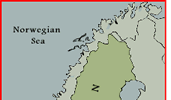
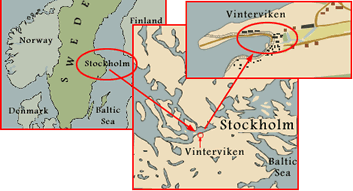
A couple of years before Vinterviken, many experiments, both in St. Petersburg and at the family laboratory at Heleneborg on the outskirts of Stockholm, had convinced Nobel that nitroglycerine was a source of progress. The truth was that there was very little knowledge about this volatile product. An explosion would occur without any apparent reason. Under other conditions it was almost impossible to get it to detonate. In 1864, Alfred Nobel was tragically confronted with its latent power. In an accidental explosion at Heleneborg his youngest brother Emil and several others were killed. As a consequence of the explosion, all manufacture of nitroglycerine was forbidden within the Stockholm city limits.
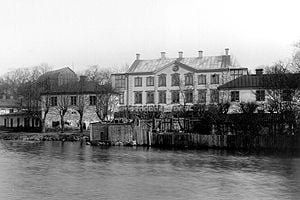 |
| Heleneborg – across the channel from Långholmen island. |
Despite worries of various kinds after this terrible event – lack of money, lawsuits, and a general hostility toward the Nobel enterprise – Alfred energetically pushed ahead with plans to restore the damaged family business. His foremost wish was to put blasting oil (the brand name for nitroglycerine) on the market and to win public confidence for it. Convinced that he was on the right track toward a safe solution, he approached J.W. Smitt, one of Stockholm’s richest men, who agreed to participate in forming a company. On November 28, 1864, a short time after the accident, Alfred Nobel established Nitroglycerin Aktiebolaget, which was not only his first company but also became the first company in the world to produce nitroglycerine commercially. Alfred and his father, together with Smitt and Carl Wennerström – a military engineer and businessman – all became shareholders. Alfred Nobel allowed the patent rights for production of nitroglycerine to become the property of the company. This was the first out of two rare occasions in his career that he ever handed over manufacturing rights once and for all to other investors. Later he always formed his own companies and made sure he himself was in charge.
The first and most important issue was to obtain a suitable site for the factory, which proved difficult after the Heleneborg explosion. Production started provisionally on an old barge at Lake Mälaren, but already in 1865 the company received official permission to move the business from the barge and build a factory at Vinterviken, an isolated inlet on the same lake, located opposite the island of Stora Essingen, not far from the city. The site was well-chosen, surrounded by high hills as protection in case of accidents and with the potential to build quays down by the water. Manufacture started under very primitive conditions; partly outdoors, partly in simple sheds.
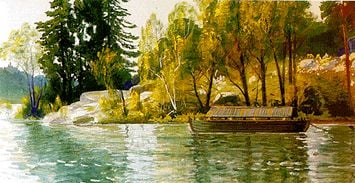
During the spring of 1866, a series of accidents occurred during shipping and storage of blasting oil, which generated much negative publicity. Nobel understood that he had to find a way of blending nitroglycerine with an absorbent material so that it could be handled and transported safely. He tested and tested: black powder, charcoal powder, wood flour, sawdust and cements. But the results were unacceptable. Then he happened to mix nitroglycerine with a highly absorbent sand known in Germany as kieselguhr (diatomaceous earth) and the mixture became a soft pliable material, like dough. Nobel succeeded in detonating the mixture with his initial blasting cap.
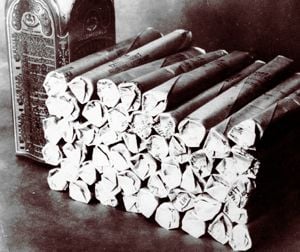 |
| Nobel’s Extra-Dynamite. |
At last he had a safe explosive, which he called dynamite. It was patented in Sweden in 1867. Dynamite was Alfred Nobel’s answer to safety demands. Production started immediately at Vinterviken. Two types of dynamite were manufactured: No. 1 with 75 percent nitroglycerine, and No. 2 with 64 percent. Demand was immediate and grew rapidly. Nitroglycerin Aktiebolaget heeded Nobel’s directive to develop dynamite even further. The products were improved, and sales increased. Blasting gelatine, patented in 1876, was introduced, followed later by Extra-Dynamite.
Records show that in the early stages, Alfred Nobel was not only the company’s president but also its chief engineer, secretary, traveling salesman, advertising manager and treasurer. Very soon, to be able to channel his energy into building what would become a worldwide industrial empire, he appointed his eldest brother Robert managing director for Vinterviken, and soon after, day-to-day operations at Vinterviken were turned over to his childhood friend, the engineer Alarik Liedbeck. This was the beginning of the fruitful collaboration, which later led to the establishment of many important factories in other parts of the world. Alfred Nobel often visited Vinterviken. He saw to it that worldwide improvements in manufacturing techniques as well as new inventions were immediately made available to Nitroglycerin Aktiebolaget. Robert Nobel was managing director for Vinterviken for a little more than three years until 1870, when he went back to Russia and St. Petersburg and became a partner in the other brother Ludvig’s successful mechanical business. Robert Nobel is remembered as one of the key figures of the early years of Nitroglycerin Aktiebolaget.
At an early stage, Vinterviken added a new nitroglycerine and dynamite factory as well as a sulfuric acid factory, all inside a fenced area with a security staff and a gatehouse. The original philosophy at Vinterviken was to produce not only the end product, but also as many of the manufacturing constituents as possible. They included various acids, saltpeter and nitrocellulose. The demand for explosives in mines, railway construction projects and building construction increased continuously.
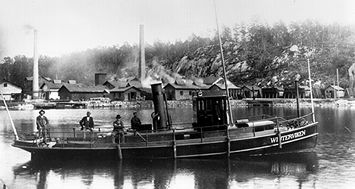 |
| Copyright © Nitro Nobel |
Right up until the 20th century, the plant in Vinterviken was plagued by accidental explosions, despite constant efforts to improve its safety. For example, small wooden buildings were erected with earthen walls between them for all hazardous work. In each building, only one or two people were allowed to work at a time. The idea was that no more than one or two people would die if there was an accidental explosion. There was also sizable property damage, but after each explosion the buildings were replaced relatively fast and always with higher production capacity, despite the protests of nearby residents. In addition, built-up urban areas were moving closer and closer to Vinterviken, which imposed limits on the quantity of dynamite produced.
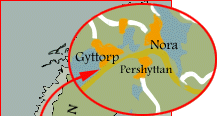
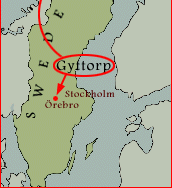
In 1915 Nitroglycerin Aktiebolaget purchased Gyttorps Sprängämnes AB, its toughest competitor in the Swedish explosives industry. This made it possible to move the increasingly crowded Vinterviken factories gradually to Gyttorp, a village belonging to the town of Nora in central Sweden. In the summer of 1921, dynamite production at Vinterviken ceased. For many years, the buildings were used as warehouses. From 1946 to 1987 the company housed its Detonics Research Laboratory in some of the buildings. In 1965 the name Nitroglycerin Aktiebolaget was changed to Nitro Nobel. Today Nitro Nobel is owned by the Norwegian-based Dyno Industrier, which also originates from an early Nobel company.
A commemorative plaque mounted on a hillside in Vinterviken recalls Nobel’s accomplishments and honors Alfred Nobel for his epoch-making inventions and all those who sacrificed their lives at the explosives factory. Another plaque was unveiled nearby the same hillside on October 21, 1983, the 150th anniversary of Alfred Nobel’s birth. The inscription reads: “This plaque marks the site of the nitrate plant built by Alfred Nobel in 1865 for the manufacture of nitroglycerine. The plant was the world’s first commercial factory for the explosive that laid the basis for Alfred Nobel’s international success as an inventor and entrepreneur.”
For many years much has fallen into decay at Vinterviken but some of the buildings are still there and the entire area is subject to substantial restoration and preservation. The old sulfuric acid factory has recently been renovated to house – on the initiative of the Swedish Sculptors’ Association – regular sculptural exhibitions and, besides, to be used as a prestigious venue for conferences and festivals of different kinds. A special room in the spacious building is designed to show the former industrial activities at Vinterviken, related to Alfred Nobel. The old renovated building has been named “The House of Sculpture,” and was officially opened on April 18, 1998.
For further information on present-day activities at Vinterviken, please contact:
Mr Gudmar Johannes
(former Head of Information Dept. at Nitro Nobel AB)
Stadsskogsv. 23
S-713 33 Nora/Sweden
Phone and fax: +46 587 31 18 58
Email: [email protected]
* Birgitta Lemmel was Head of Information of the Nobel Foundation in 1986-1996.
First published 29 June 1998.
